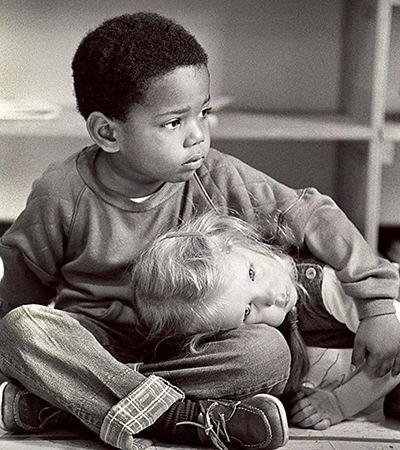An Education for Peace
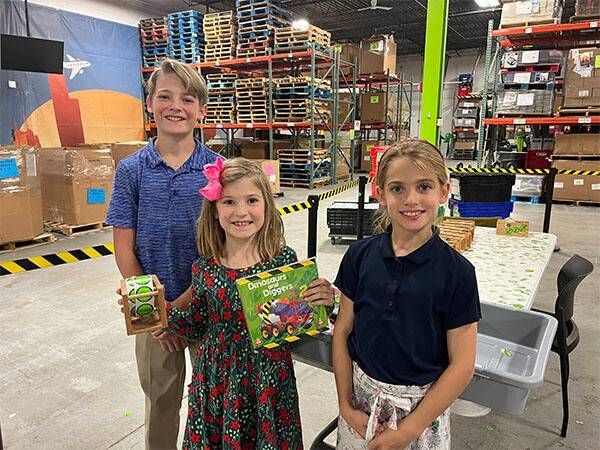
The beginning of the year provides us with an opportunity to practice intentionality and thoughtfulness in our values. We can establish these qualities into our routines, carrying them through our experiences for the rest of the year. Martin Luther King Jr. Day is an inspiration for many families as they consider how they can contribute to their community with compassion and action. January is an invitation to families to think about other people and the needs of the world around us. Dr. Maria Montessori observed that humans are the only species who can imagine the lives of others and love people whom we have not even met. This capacity is unique to being human and is an important quality for us to encourage and nourish in ourselves and our children. Compassion and the ability to know how to help are two of the most important gifts we can give to humanity. A Montessori Perspective on Service There is no one-size-fits-all approach to community service with children. This concept does not belong only to Montessori, but it is a distinctive and persistent feature of the philosophy. A part of considering how best to find ways to volunteer with your children is by first understanding their phase of development. We know from Montessori’s observations that 0-6 year-olds do best with simple, hands-on activities that do not require prolonged efforts. 6-12 year-olds have a greater capacity for abstract work, and they are often motivated by social connection. 12-18 year-olds are ready for independence and deep engagement, and can understand more about why our world has the challenges that it has. Additionally, every parent must know the idiosyncrasies of each of their children—how much to expose them to in order to cultivate their compassion and desire to help without overwhelming them. Some children can handle witnessing more of the world’s pain and needs, while others will shut down. While this capacity tends to increase with age, it also is individual to each person. A parent can best support their children when they are observant and sensitive to their personalities. Talking About Service Parents need to be sensitive to what kind of language their children are ready for when discussing why other families and communities have greater needs for donations than others. For the youngest children, a simple explanation will suffice: “For some families, it is harder for them to pay for the food they need. We are so lucky that we have enough. We can help make their lives easier by giving them food so they don’t have to pay for it.” This kind of explanation works for a variety of services. Simply expressing that it is harder for other families and that your family is in a position to help creates the idea of a need for service without overwhelming their imaginations. Older children may be able to handle more information, but parents should proceed cautiously. Children have active imaginations and porous empathy. We want them to love the world and believe in the magnitude of its goodness before presenting the entirety of the world’s problems to them. For the most part, we have the privilege of allowing the children at our school to spend their childhood unjaded so that they develop the capacity for hope. A palpable sense of hope and a belief in how good the world can be will inspire selfless action as they mature. Ideas for Community Service Book, Food, or Clothing Bank These organizations all collect items such as books, food, or clothing and then distribute them to people, families, and communities who need them. Ask around your town or city to find one that has a simple donation strategy. Here in Lake Bluff, IL, where Forest Bluff School is located, Bernie’s Book Bank provides many opportunities for children of all ages to volunteer and contribute. The jobs at the facility range in simplicity. There are accessible tasks for young children, and there are more complex tasks for older children. The staff take the time to share stories about the families who are impacted by book donations, making the work feel meaningful. For banks that don’t offer volunteer opportunities, it is easy to organize a drive, or to gather items from your house with your family. Older children can design flyers and go door-to-door in their neighborhood, collecting items from other homes. Younger children can help put food, clothes, or books in bags or boxes. They can take part in determining what they are ready to part with from your own home. And they can all help bring the items to the organizations, witnessing the smiles of the staff members and the way that their work becomes a part of greater efforts. In all of these cases, it is important to gauge the capacity of each of your children. Parting with clothes they have outgrown is easier than parting with books that they may still love, even if they have technically outgrown them. And choosing food at the grocery store will be easier than parting with clothes. Nothing will be gained by forcing them to give things away that they are not ready to give away! If they are resisting identifying clothes or books that they do not need anymore, then leave the metaphorical door open for them: “I can see that you are still attached to your books. I love how much you love to read! I’ll check in another time to see if there are any that you are ready to give to another family.” For this child, they likely will be more receptive to a food bank. They can help you pick out their favorite kinds of canned or boxed food (or fresh food if your bank accommodates that), and then practice being generous in this way. Cookie, Lemonade, or Hot Chocolate Stand These kinds of stands tend to be more suited for older children, who can decide what items they will sell and help choose a charity or organization to donate proceeds to. Let them follow their passion and interest, and, to the extent that they can handle it, let them guide the research on what is important to them as they determine who to help. The children can make signs, set up the table, prepare the food or drink in the kitchen, and then be responsible for managing the sales. Make sure they know how to tell passersby what they are raising money for! Point out to them how much people love donating for a worthy cause. Pro tip: If you have Venmo or Zelle, you can print a QR code for people to use to buy goods. This will help them catch people who do not carry cash on them.
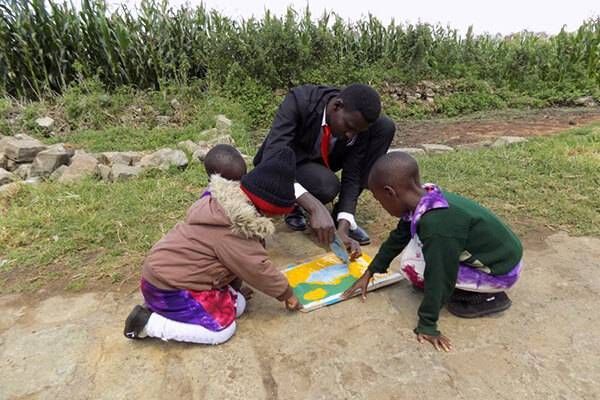
When You’re Feeling Discouraged… When you ingest the popular news these days, you may feel very down, anxious, angry or helpless. I know I certainly do. But when I turn to see the natural world around me, the beautiful people, and especially children, I am instantly reminded of the good in the world. Maria Montessori’s vision of children’s education–and the more peaceful world she proposed would result–always inspires me and gives me strength. Lately, I have learned of some very exciting initiatives happening all around the world because of Maria Montessori! These programs are being enthusiastically embraced and are growing steadily. Any involvement with Montessori–even if it be just mentioning it to others, raising your children with a Montessori approach at home, or sending your children to a Montessori school–includes you in this path of making the world a better place!
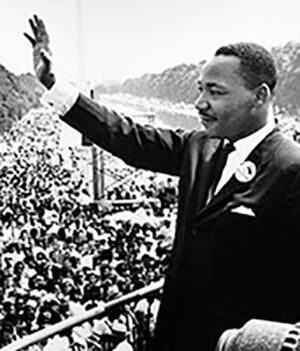
On Monday, January 18, 2021, our nation remembers the life of Martin Luther King, Jr.—a man who dedicated his life to seeking equity for all of humanity. The events of this past year have reminded us that we are best able to serve this goal when we listen, learn, and focus on the positive moral development of children. Here, we re-post a blog written one year ago that reflects on the connections between Dr. King and Dr. Montessori, and shares the many ways that the Montessori approach supports Dr. King’s beliefs about peace and equity. A Shared Vision of Peace The arc of the moral universe is long, but it bends towards justice. — Dr. Martin Luther King, Jr. Establishing lasting peace is the work of education; all politics can do is keep us out of war. — Dr. Maria Montessori As millions around the country celebrate the life and legacy of Dr. Martin Luther King, Jr., we have an opportunity to consider his lasting impact in our lives: how we may honor his teachings throughout the year as well as in our daily practices; and the symbiosis that exists between Dr. Martin Luther King, Jr.’s and Dr. Maria Montessori’s teachings. While there is much that can be written about the overlap between these humanitarians’ philosophies and work, here we offer a brief reflection on how we embrace Dr. King’s values in a Montessori community. Martin Luther King, Jr. shares his vision for peace

I can honestly say that my heart has never felt more filled with wonder at this world or gratitude for human life within it. As I took my dogs out at 6 o’clock this morning, my first sight was of the full moon, still completely visible through the tree’s bare branches beyond the pond and pasture. When I turned east back toward the house, the brilliant red beams of the rising sun were just peeking through the tree limbs to the east; the moon and the sun at once! A glorious sight I had never seen at our house before. Then I received an image on my iPhone sent by my doctor son-in-law of the Virginia countryside by his home. He had taken it with his drone. Human ingenuity throughout the ages has brought us such wonder! Scientists around the globe, working together to defeat a common enemy to our health; inventions that boggle the mind, owned and operated by individual citizens; and the beauty of the earth that out of the darkness of winter each year brings us the light of spring in all its glory. Truly we are the most blessed of all the peoples who yet have lived!
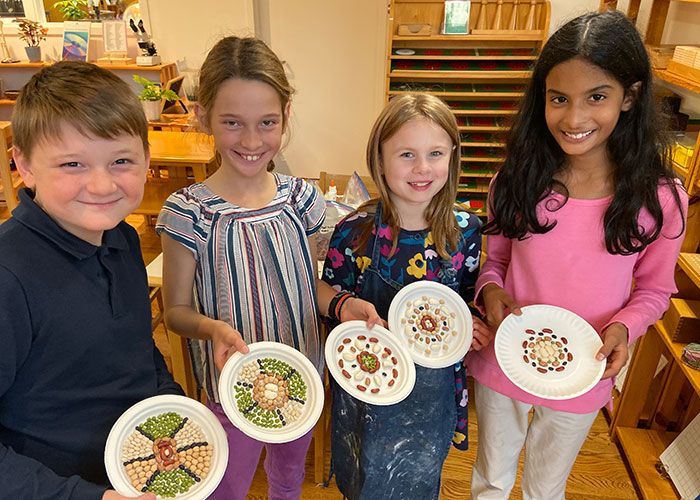
We think different things when we hear the word diversity. Some may think of variety in skin color or socioeconomic backgrounds, others may think of different languages or cultures. Whatever your family, community, or school is like, understanding and embracing diversity and building connections between people is imperative. I am not an expert on diversity but will share how I believe Dr. Montessori’s approach guides and helps children to appreciate and value human diversity.

